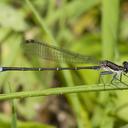United States and Canada
The head of the male is largely black. There is a pair of small postocular spots separated by an occipital bar visible in younger individuals. The antehumeral stripe is violet and nearly twice as wide as the black middorsal thoracic stripe. The broad black humeral stripe ranges from half to the entire width of the antehumeral stripe. The metapleuron and ventral side of the thorax are pale yellow, often becoming darker and cover ed with pruinescence in older males. There is a distinct black stripe along the metapleural suture. The legs are largely black with a thin pale stripe on the outer surface of the femora and a broader pale stripe on the tibiae. The tarsi are black and armed with short spurs. There are 4 and 3 postquadrangular cells in the fore- and hindwings, respectively. The abdomen is largely black dorsally with only a thin pale middorsal line on segments 1-7. Segments 3-7 each have a narrow pale basal ring and their ventrolateral margins are pale for 3/4 of their length. Segment 8 is entirely black and segments 9-10 are blue dorsally with a wide ventrolateral black stripe. The cerci are short, only 1/3 the length of segment 10 and distinctly bifid dorsally. The paraprocts are also bifid with the superior lobe larger and generally extending beyond the inferior lobe. The female color is generally light tan or pale blue. The head is colored much like a male, but the pale areas are generally more extens ive. The postocular spots are larger and sometimes partially confluent with the occipital bar. There is a pair of pale dorsal spots on the prothorax in addition to the larger lateral spots. The pterothorax is like male, but with the wide humeral stripe forked at its upper end. There are no posterior lobes on the mesostigmal plates and the mesepisternal tubercles are lacking entirely. The abdominal color pattern is the same as the male on segments 1-7. Segments 8-9 are black. There is generally a pale middorsal spot that may be confluent with pale lateral areas apically on segment 9. Segment 10 is pale, sometimes with dark basal spots visible.
Size: Total length: 30-38 mm; abdomen: 23-30 mm; hindwing: 18-24 mm.
Similar Species (south-central US): Blue-tipped Dancer is the only dancer in the south-central United States in which males have abdominal segment 8 black and 9-10 blue. Females are probably most easily distinguished from other dancers by the contrasting pale bottom and sides of the thorax and generally black abdomen.
Habitat: Streams and rivers of various flows, also sloughs.
Natural History: Bick (1957 ) wrote that in Louisiana, the specimens he collected were "...from a wider range of habitats than any Argia in Louisiana." In the pinelands, Blue-tipped Dancer occurred along swift creeks (73%), sluggish streams (9%), and near sloughs, swamps or ponds (5%). This species usually perches on the ground, but does perch on vegetation and in shade more than most other dancers. Egg laying occurs in tandem and eggs are generally deposited in floating eelgrass or debris, but sometimes in wet wood above the water line. This species often occurs in large aggregations.
Distribution: Eastern U.S. from Florida to Pennsylvania west to Minnesota south to Texas.
Source: Abbott, J.C. 2006-2010. OdonataCentral: An online resource for the distribution and identification of Odonata. Available at OdonataCentral.
Edited by Drew Weber (9/24/2015).
